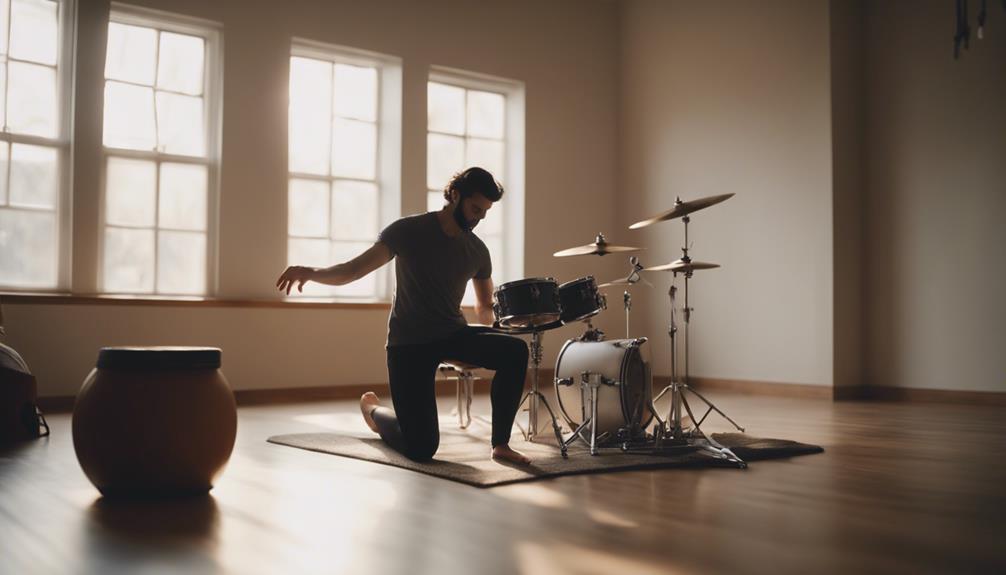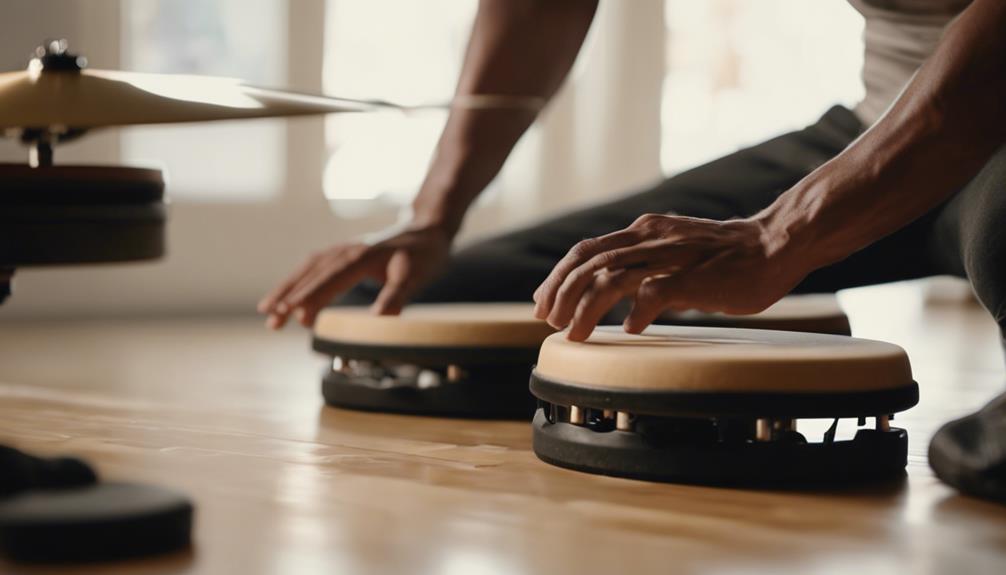Developing limb independence is essential for any musician looking to enhance their drumming skills. You’ll want to start by isolating each limb, focusing on simple, repetitive exercises that build muscle memory and coordination. Using a metronome can help you maintain consistent timing and keep track of your progress. Initially, play quarter notes on the hi-hat and snare to master basic rhythms before tackling more complex patterns. Visualization techniques can also aid in understanding how each limb should move. Wondering how to overcome common challenges and take your drumming to the next level? Let’s explore some advanced exercises.
TL-DR
- Start with simple exercises at a slow tempo to build muscle memory and control.
- Use a metronome to maintain consistent timing and track progress.
- Practice basic coordination drills, focusing on synchronizing hands and feet.
- Gradually increase complexity by incorporating different limb combinations and rhythms.
- Utilize visualization techniques to mentally prepare and enhance coordination.
Importance of Limb Independence

Mastering limb independence is essential for drummers to execute complex rhythms with precision and creativity. By honing this skill, you can effectively play intricate rhythms and polyrhythms, which are vital for dynamic and engaging drumming. Limb independence isn’t just about moving your hands and feet separately; it’s about coordinating them in such a way that each can perform a different pattern simultaneously without interfering with the others.
Developing limb independence greatly enhances your coordination. When your hands and feet work independently, you’re able to tackle more complicated drumming patterns and techniques. This increased coordination opens up a world of creative possibilities, allowing you to craft unique grooves and styles that set your drumming apart from others.
Moreover, mastering limb independence isn’t just a physical endeavor; it also sharpens your cognitive skills. The mental focus required to keep each limb performing its own task boosts your overall dexterity and brain function. As you practice and build this independence, you’ll find that even the most challenging drumming patterns become more manageable.
Essentially, limb independence is your gateway to more expressive, innovative, and technically proficient drumming.
Start Slow and Simple
When starting, focus on isolating each limb with basic rhythmic exercises to build a solid foundation. Gradually increase the speed as you gain confidence and control.
Isolate Each Limb
To develop limb independence, start by isolating each limb to focus on individual movements and coordination. This method guarantees you build solid limb coordination from the ground up.
Begin with simple exercises that require only one limb at a time. For example, try tapping your right foot steadily while keeping your hands still. This helps build muscle memory and control in that particular limb.
It’s essential to start slow. Rushing through the exercises can lead to sloppy movements and poor technique. Take your time to make sure each motion is accurate.
Gradually increase your speed as you become more comfortable with the movements. This slow progression allows you to master the basics before moving on to more complex patterns.
Basic Rhythmic Exercises
Starting with basic rhythmic exercises will help lay the foundation for developing limb independence. Begin by playing quarter notes on the hi-hat and snare simultaneously. This simple pattern allows you to focus on the mechanics of your Right Hand while keeping steady timing. It’s important to start slow to guarantee accuracy. Use a metronome, which will help you maintain consistent timing and track your progress.
Next, practice simple patterns with each limb individually. For instance, play quarter notes with your Right Hand on the hi-hat while keeping the snare silent. Then, switch to playing the snare with your Right Hand while leaving the hi-hat silent. Once you’re comfortable with these individual exercises, you can start combining them.
Experiment with different combinations of limb movements to challenge your coordination. Try playing eighth notes with your Right Hand on the hi-hat while maintaining quarter notes on the snare with your left hand. As you practice, listen closely to make sure each note is clean and precise.
Gradual Speed Increase
Now that you’ve mastered basic rhythmic exercises, focus on gradually increasing your speed to enhance limb independence. Start by practicing your exercises at a slow tempo, which allows you to maintain accuracy and coordination. This foundational approach guarantees you have better control over each limb, helping you develop true independence.
As you become more comfortable and proficient with the movements, you can start to incrementally increase the speed. However, keep in mind that rushing this process can lead to sloppiness and mistakes, which can hinder your progress. Patience and consistency are key to making substantial improvements.
To effectively implement gradual speed increases, follow these steps:
- Set a Metronome: Use a metronome to keep a steady tempo. Start at a slow pace and only increase the speed when you can perform the exercise flawlessly.
- Incremental Increases: Raise the tempo in small increments, such as 5-10 BPM (beats per minute). This allows your limbs to gradually adapt without overwhelming your coordination.
- Regular Review: Periodically drop back to a slower tempo to confirm your form and accuracy remain intact. This helps reinforce proper limb control and prevents bad habits.
Exercises for Beginners

Start with basic coordination drills by playing quarter notes with one hand while tapping quarter notes with the other.
Focus on simple rhythm patterns and practice at a slow tempo to build a solid foundation.
Use a metronome to guarantee you’re staying in time and gradually increase the complexity as you improve.
Basic Coordination Drills
To build a strong foundation in limb independence, begin by mastering basic coordination drills that synchronize your hands and feet. Start with simple exercises that focus on developing your timing and coordination.
Here are three essential drills to get you started:
- Quarter Notes on Hi-Hat with Snare Drum on 2 and 4: Play quarter notes on the hi-hat while hitting the snare drum on beats 2 and 4. This basic pattern helps you synchronize your limbs and build a solid rhythmic foundation.
- Slow Paradiddles (RLRR LRLL): Practice paradiddles slowly to develop coordination between your hands. This rudiment is essential for improving hand independence and control. Make sure each stroke is even and consistent.
- Basic Rock Beat with Bass Drum Variations: Play a basic rock beat, incorporating a simple bass drum pattern. Start with a straightforward 4/4 beat and gradually add more complexity as you become comfortable. This drill enhances your ability to play different rhythms with your hands and feet simultaneously.
Use a metronome to stay on time and gradually increase the tempo as you improve. Consistent practice with these drills will strengthen your coordination, making more advanced patterns easier to tackle later on.
Simple Rhythm Patterns
Many beginners find mastering simple rhythm patterns crucial for developing their limb independence. Start with basic rhythm patterns like quarter notes on the hi-hat and snare hits on beats 2 and 4. Practicing these patterns with each limb individually before combining them is essential.
For instance, focus on playing the hi-hat with your right hand and add the snare with your left hand on the designated beats.
Next, incorporate your left foot by practicing bass drum hits on specific beats. For example, play the bass drum on beats 1 and 3 while maintaining the hi-hat and snare pattern. This helps you get comfortable with using all four limbs independently.
Remember to maintain a steady tempo while playing different rhythms with each limb. A metronome is a valuable tool for ensuring precision and consistency in executing the rhythm patterns. Set it to a moderate tempo and gradually increase the complexity of your patterns as you gain confidence.
Slow Tempo Practice
Building on your ability to play simple rhythm patterns, practicing at a slow tempo will help you focus on accuracy and coordination. Starting with a slow tempo allows you to concentrate on each limb’s movement without feeling rushed. This method is especially useful for beginners aiming to develop limb independence.
Here’s a structured approach to slow tempo practice:
- Quarter Note Exercise: Play quarter notes with your right hand while maintaining a steady beat with your left hand. This helps synchronize your hands, building a solid foundation.
- Adding the Right Foot: Introduce your right foot by tapping along with the beat. Start by coordinating it with the quarter notes played by your right hand, then challenge yourself by playing it on off-beats.
- Incremental Complexity: Gradually add more rhythms and limbs. For instance, add your left foot to play hi-hat pedals while your hands and right foot maintain their respective parts.
Consistent slow tempo practice is essential for mastering complex drumming patterns. By focusing on each limb’s role and gradually increasing complexity, you’ll build a strong foundation, ensuring each limb can operate independently.
Keep practicing patiently, and you’ll see significant improvements in your drumming skills.
Use of Metronomes
When you incorporate the use of a metronome into your practice routine, you’ll quickly notice improvements in your timing and coordination. This tool is essential when working with a drum set, as it provides a steady beat that helps you develop precise timing and coordination between your limbs. By setting a consistent tempo, the metronome assists you in practicing complex rhythms, ensuring all your limbs follow the same beat.
Adjusting the tempo on your metronome allows you to challenge yourself at different skill levels. Start slow to build a solid foundation, then gradually increase the speed as you become more comfortable. This process not only builds muscle memory but also enhances your overall rhythmic accuracy.
Consistent metronome practice enhances your limb independence by forcing each limb to operate in sync yet independently. You’ll find it easier to master challenging drumming patterns over time. As you practice, focus on maintaining the beat with each limb individually. This method helps isolate and strengthen each component of your drumming technique.
Visualization Techniques

Visualizing your limb movements before playing drums can greatly enhance your coordination and accuracy. When you mentally picture each limb’s actions, you’re not just preparing to play; you’re building muscle memory and improving your timing. This mental imagery trains your brain to understand each limb’s role in a drumming pattern, making it easier to execute complex rhythms.
By visualizing limb movements, you can also imagine the spatial relationships between your arms and legs, which is essential for developing independence. Think about how your right hand hits the snare while your left foot works the hi-hat. This kind of mental practice helps you execute these actions more fluidly when you actually sit down to play.
To incorporate visualization techniques effectively, try these steps:
- Close your eyes and mentally rehearse: Picture each limb’s movement in slow motion before you play a new pattern.
- Focus on one limb at a time: Visualize what your right hand is doing, then switch to your left foot, and so on.
- Imagine the whole pattern: Once you’ve visualized individual movements, combine them to see the entire drumming sequence in your mind.
Using these visualization techniques will lead to better coordination and a more polished performance.
Breaking Down Movements
To master limb independence, start by isolating each limb’s movements. Practice slowly and focus on one limb at a time before combining them.
Once you’re comfortable, try integrating simple patterns to build coordination.
Isolate Each Limb
Start by focusing on isolating each limb, practicing individual movements without the full drum set. This approach helps you understand the role and function of each limb, making it easier to break down complex patterns.
For example, start with your right foot. Practice simple bass drum patterns to build muscle memory and improve coordination. Concentrate on the movement and feel of each stroke.
Here are three steps to help you isolate each limb effectively:
- Right Foot Exercises: Sit at your drum kit or on a practice pad and focus solely on your right foot. Play quarter notes, eighth notes, and sixteenth notes. Gradually increase speed as you become more comfortable with the patterns.
- Hand Independence: Use a practice pad to work on your hands separately. Play basic rudiments with one hand while keeping the other hand still. Switch hands and repeat the exercises. This helps in building hand independence and coordination.
- Visualize Movements: Before you start playing, close your eyes and visualize the movements of each limb. This mental practice can greatly enhance your limb independence and prepare you for actual play.
Slow Practice Sessions
Slow practice sessions are key for mastering limb independence in drumming. Breaking down movements into smaller parts allows focused attention on individual limb coordination. Starting with practicing each limb separately – for example, right hand snare hits followed by left hand hi-hat patterns – helps isolate movements and develop muscle memory.
Analyzing hand and foot movements separately is the next step. Understanding how your hands and feet interact within a rhythm deepens overall coordination. During slow practice sessions, it’s crucial not to rush but instead focus on the mechanics of each movement.
Once comfortable, gradually increasing the tempo is more effective than jumping into fast-paced practice. The goal of slow practice is to establish a strong foundation of muscle memory and coordination. By practicing slowly and breaking down movements, you prepare yourself to handle complex drumming patterns effortlessly. Consistent and patient practice is key to achieving the best results.
Combine Simple Patterns
Combining simple patterns is crucial for mastering drumming coordination and achieving limb independence. Start by breaking down drumming patterns into simple movements. Focus on playing quarter notes with one limb at a time. For instance, use your right hand to play quarter notes on the hi-hat while keeping the other limbs still. Once you’re comfortable, move on to the next limb.
Here’s a step-by-step approach to combining patterns:
- Isolate Each Limb: Begin with basic exercises for each limb. Play quarter notes with your right hand on the hi-hat, left hand on the snare, right foot on the bass drum, and left foot on the hi-hat pedal.
- Combine Two Limbs: Once you’re confident playing quarter notes with each limb individually, combine two limbs. For example, play quarter notes on the hi-hat with your right hand while playing the bass drum with your right foot.
- Add Complexity Gradually: As your coordination improves, combine more limbs and introduce more complex patterns. Play quarter notes with your right hand and bass drum while adding snare hits with your left hand.
Practice slowly and accurately to make sure each limb plays its part correctly. Visualization techniques can also help you mentally prepare for combining different patterns.
Practicing on the Go

Whether you’re commuting or taking a break, there are plenty of effective ways to practice limb independence on the go. One of the simplest methods is using a practice pad. These portable tools allow you to work on your drumming skills without needing a full drum set. Keep a small practice pad in your bag and pull it out whenever you have a few free minutes.
Utilize finger drumming exercises on mobile apps while you’re on the bus or train. These apps can simulate a drum kit and help you develop coordination and rhythm. If you don’t have a practice pad or app handy, you can still practice by tapping out rhythms on your thighs or a tabletop. This helps to build muscle memory and improve your limb coordination.
Another useful technique is mental practice. Visualize drumming patterns and movements while you’re away from your drum set. This mental exercise can be surprisingly effective in reinforcing your skills. Experiment with polyrhythms and ostinatos in your mind to further enhance your limb independence.
Advanced Drumming Exercises
As you build on your on-the-go practice, let’s explore advanced drumming exercises that will further enhance your limb independence and overall drumming skills. By focusing on specific techniques and patterns, you can greatly improve your coordination and creativity behind the drum kit.
First, practice paradiddles and double strokes to refine your hand-to-hand coordination. These exercises are essential in developing precision and control, which are vital for advanced drumming.
Second, try using ostinato patterns on the hi-hat while playing different rhythms on the kick and snare. This will help you develop the ability to maintain a steady beat with one limb while performing complex rhythms with the others.
Finally, incorporate polyrhythmic exercises like playing 3 against 4. This type of practice challenges your coordination skills and pushes the boundaries of your limb independence.
Here’s a summary of key exercises:
- Paradiddles and Double Strokes: Improve hand-to-hand coordination.
- Ostinato Patterns: Use on the hi-hat while playing different rhythms on the kick and snare.
- Polyrhythmic Exercises: Play 3 against 4 to challenge your coordination.
Read drum-specific guides and practice regularly to master these techniques and boost your drumming prowess.
Common Challenges

Drummers often face significant challenges when trying to develop limb independence, especially when coordinating hands and feet to play different patterns accurately. One common obstacle is syncing up your movements. For instance, your right foot might be playing a steady bass drum pattern while your left hand handles a complex snare rhythm. This can make it difficult to maintain consistent timing, which is important for a tight performance.
Another challenge is the tendency to revert to familiar patterns when you’re under pressure. Your brain naturally wants to sync your limbs, making it hard to keep them playing independently. To overcome this, you need focused practice sessions where you isolate each limb’s role. Start with basic exercises and gradually increase the complexity as you become more comfortable.
Patience is key. You won’t master limb independence overnight. Consistent practice sessions will help you build the necessary muscle memory and coordination. Working on your right foot’s independence, for example, can greatly enhance your overall drumming skills.
As you conquer these challenges, you’ll open up possibilities for more intricate and dynamic drumming patterns, ultimately enhancing your musical expression and performance.
Progress Tracking
Monitoring your progress is essential for mastering limb independence in drumming. Keeping track of your improvements not only keeps you motivated but also helps you identify areas that need more work, such as your Left Hand. Here are three practical ways to track your progress:
- Keep a Practice Journal: Document your daily exercises, noting specific goals and achievements. Write down any challenges you face with your Left Hand or other limbs. This journal will serve as a valuable reference to measure your growth over time.
- Record Your Sessions: Use audio or video recordings to capture your practice. Reviewing these recordings helps you see and hear how your limbs are moving and coordinating. Compare these recordings periodically to observe improvements in limb independence and to pinpoint areas where your Left Hand might need more attention.
- Use a Metronome: A metronome is an excellent tool for monitoring tempo changes and coordination. Set specific tempo goals and track your ability to maintain steady rhythms with each limb. This will help you see how well your Left Hand and other limbs are syncing with the beat.
Additional Learning Tools

To enhance your drumming skills, take advantage of a variety of additional learning tools available today. Drumming apps like Drumeo and DrumGenius offer interactive practice sessions that can specifically help you work on your limb independence. For instance, you can focus on exercises to strengthen your left hand, which is often less dominant for right-handed drummers.
Exploring online drumming courses on platforms like Udemy or Coursera can provide you with structured learning paths. These courses often include specific modules on developing limb independence, ensuring you get targeted practice for improving coordination between all four limbs.
Using drumming software like Superior Drummer or EZdrummer gives you access to realistic drum sounds, making your practice sessions more engaging. This software can help you isolate different limbs, including your left hand, for focused practice.
Experimenting with drumming plugins for recording software, such as Addictive Drums or Steven Slate Drums, allows you to record and analyze your drumming. This can be particularly useful for identifying areas where your left hand might need more work.
Next up, learn how to tune your drums in this guide.
